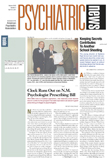Child and adolescent psychiatrists have their work cut out for them. If they wanted to treat the 15 million children and adolescents in the U.S. with a diagnosable psychiatric disorder, each one would have a caseload of 2,381 youngsters—a tall order for even the most hard-working physician.
This is according to Wun Jung Kim, M.D., M.P.H., who cited data from the American Medical Association and the Surgeon General’s Report on Mental Health from 1999.
“The children in this nation who are in need of expert care do not get it, and this is disheartening,” said Kim, who is director of the division of child and adolescent psychiatry and residency training at the Medical College of Ohio and chair of the American Academy of Child and Adolescent Psychiatry’s (AACAP) Task Force on Work Force Needs. Kim presented some eye-opening data on the critical shortage of child psychiatrists at the annual meeting of the American Association of Psychiatric Residency Training Directors (AADPRT) in Seattle in March.
“We are the wealthiest nation in the world,” said Kim, “yet our system of care is pathetic, and many children don’t even have access to the services provided by mental health professionals, let alone a child psychiatrist.”
While the U.S. Department of Health and Human Services last year estimated that the demand for services provided by child and adolescent psychiatrists will increase by 100 percent between 1995 and 2020, the number of residents emerging from child and adolescent psychiatry programs is not promising. According to data from the Accreditation Council on Graduate Medical Education’s Resident Review Committee and the AMA Census on Graduate Medical Trainees, there were 712 child and adolescent residents in 1989-1990 and 719 residents in 1999-2000—a level that has been consistent for the past decade. Kim said that increasing educational debt, pressure to pursue a career in one of the primary care specialties, a long training period, and reimbursement problems are some of the factors that discourage medical students from choosing a career in child and adolescent psychiatry.
According to Kim, managed care organizations are more hesitant to reimburse psychiatric treatment for children and adolescents than they are for adults.
“When a teenager says, ‘I want to kill myself,’” said Kim, “the managed care organization may see this as an attention-getting gesture and may not reimburse treatment. If a 63-year-old man says the same thing, the managed care organization is more likely to take him seriously.”
Some families have an especially hard time accessing a child psychiatrist because of uneven geographic distribution of those specialists. For example, according to a 1999 study by Christopher R. Thomas, M.D., and Charles E. Holzer III, Ph.D., in Mississippi, a poor, rural state, there were 0.8 child and adolescent psychiatrists per 100,000 youths. In Massachusetts, however, researchers estimated there were 6.7 child psychiatrists per 100,000 youths.
“The serious undersupply of child and adolescent psychiatrists has resulted in children receiving inadequate care from mental health professionals who lack the necessary training,” said Kim. “Pediatricians and primary care doctors will often try to refer children with a mental illness to child psychiatrists and become frustrated because the child psychiatrists are just not available.” Kim added that pediatricians often rely on psychologists or social workers for psychotherapy and other nonmedication-related services.
Funding problems for child and adolescent psychiatry programs are in part due to the 1997 Balanced Budget Act, according to Kim. This legislation reduced direct funding for graduate medical education for subspecialty training by half.
AACAP’s Task Force on Work Force Needs has made a number of recommendations to increase the recruitment of child and adolescent psychiatrists, said Kim (
see box on page 26). Recommendations include the promotion of mentorship for medical students and residents and advocacy for increased research funding in child and adolescent psychiatry.
More information about the workforce crisis in child and adolescent psychiatry can be obtained by calling Kayla Pope at (202) 966-7300, ext. 113, or sending an e-mail request to [email protected]. ▪
